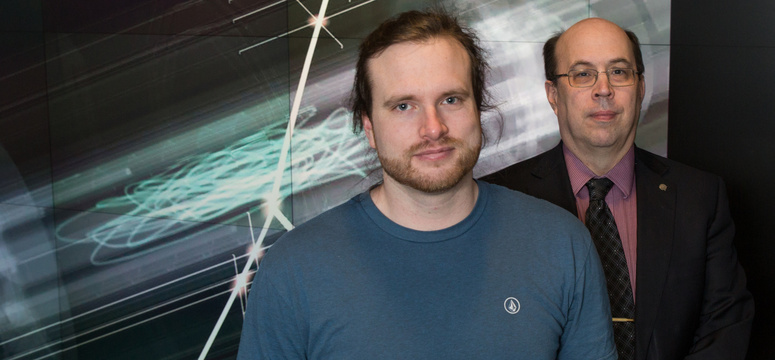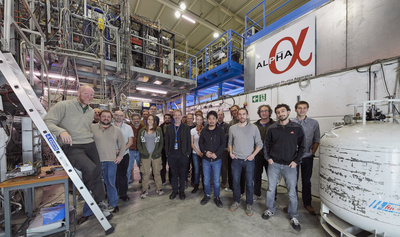An international collaboration that includes University of Calgary scientists has measured a frequency of light or optical "fingerprint" of antimatter for the first time.
The ALPHA collaboration, in an experiment done at the CERN particle physics laboratory in Geneva, Switzerland, used a laser to observe and measure the optical spectrum of an antihydrogen atom.
This spectroscopic measurement, which allows the light spectrum of matter and antimatter to be compared for the first time, brings scientists a significant step closer to unravelling the mystery of antimatter and how our universe formed.
“ALPHA is testing the very foundation of physics. We’re trying to see if there’s anything missing in our understanding of the world around us,” says Rob Thompson, department head and professor in the Department of Physics and Astronomy in the Faculty of Science, and a longtime member of ALPHA.
Based on the new finding, “so far, our fundamental theories in physics are consistent,” he says.
The team’s research, "Observation of the 1S-2S Transition in Trapped Antihydrogen," is published in the top-ranked journal Nature.
Where is all the antimatter?
Physics is governed by a set of fundamental theories or symmetries, which requires equal amounts of matter and antimatter to have been produced in the Big Bang that created the universe.
These symmetries also require matter and antimatter to be identical mirror images of each other. The paired subatomic particles that make up matter have, respectively, a positive and a negative electrical charge. So the paired particles that make up antimatter should have the opposite charge — the mirror image.
The mystery is that everything in the observable universe appears to be made of matter. So is the antimatter hiding somewhere or does the universe actually consist mostly of matter?
“In either case, it suggests there’s something missing in our understanding of the physical world,” says Thompson, a member of the University of Calgary’s Quantum Optics Research Group.
“The goal of ALPHA from its launch over a decade ago was and continues to be to test and measure that ‘mirror image-ness’ of matter and antimatter.”
New discovery took 10 years of work
The ALPHA collaboration includes about 50 scientists — about one-third from Canada — from 14 institutions in seven countries.
To achieve its newest milestone, the ALPHA team first spent years figuring out how to make, trap and finally study antimatter by manipulating its subatomic particles, called antiprotons and positrons.
By 2011, the team had built and used an apparatus called ALPHA-1 to successfully trap and hold antihydrogen in magnetic confinement fields for 15 minutes or more.
The team then built a second-generation apparatus, called ALPHA-2, which enabled them to use a laser beam to measure a precisely tuned frequency of light, called a spectral line, absorbed by the antihydrogen.
The researchers found no difference between the antihydrogen and the equivalent spectral line in hydrogen. Both the antimatter and the matter absorb light at the same frequency, indicating that to a precision of a few parts in 10 billion, the current laws of physics hold.
“We now know how to measure this property in antimatter, and we know the techniques we can use to continue to push the precision frontier further and further,” Thompson notes.
Doing so may reveal whether there are any differences between matter and antimatter. Even small differences will open up a whole new realm of physics.
State-of-the-art ‘refrigerator’ built on campus
A key to ALPHA’s successful experiment was being able to cool the fast-moving antiprotons and positrons that constitute antimatter, sufficiently slowing down these particles to make antihydrogen and trap it long enough to be studied.
An essential component required to accomplish this extreme cooling is a sophisticated ‘refrigerator’ or cooling device called a cryostat, mostly fabricated in the Faculty of Science’s Science Workshop.
The device was designed at ALPHA-Canada’s home institution TRIUMF, Canada’s national subatomic physics laboratory located in Vancouver.
Using liquid helium as a coolant in a vacuum-tight chamber, the cryostat chills the experimental ALPHA apparatus from 20 degrees Celsius to close to minus 270 degrees C or nearly absolute zero degrees Kelvin.
“That allows us to start with the antimatter particles cold enough that we can then use other techniques to cool them further so we can trap and study them,” Thompson says. “We couldn’t have done the experiments without the cryostat.”
The ALPHA team is now designing and constructing ALPHA-g, a new vertical apparatus to measure whether dropped antimatter will fall exactly like matter in Earth’s gravity.
The University of Calgary is leading this multinational Canada Foundation for Innovation project, with about 80 per cent of the funding provided by Canada including contributions from provincial partners Alberta, British Columbia and Ontario.
UCalgary PhD student Andrew Evans and post-doctoral fellow Chukman So are currently working on ALPHA-g and ALPHA-2. UCalgary graduate students also participated in previous experiments using both ALPHA-1 and ALPHA-2.
Click here for a video on ALPHA’s latest experiment.









